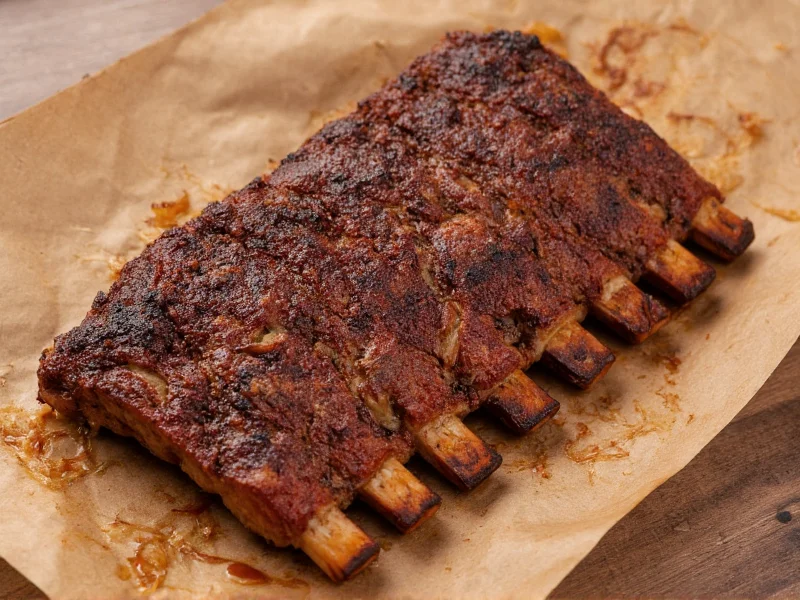Short ribs are almost always cut from beef, not pork. While pork has various rib cuts like baby back ribs or spare ribs, the specific term "short ribs" refers exclusively to a cut from the beef plate section (ribs 6-9), located just below the rib primal. This is a factual culinary distinction recognized by butchers, chefs, and meat industry standards worldwide.
Understanding the confusion around short ribs requires examining both meat categories. The term "short ribs" specifically describes a beef cut taken from the plate section of the cow, which includes the lower portion of ribs six through nine. These ribs are "short" because butchers cut them between the bones, creating shorter sections compared to traditional rib cuts.
Pork does have rib cuts, but they're never called "short ribs." Instead, you'll find terms like baby back ribs, spare ribs, or St. Louis-style ribs when referring to pork. The confusion often arises because both meats have rib sections, but the terminology differs significantly between species.
Why People Confuse Short Ribs Between Beef and Pork
The confusion typically stems from three factors:
- Similar anatomical location - Both animals have rib sections, though the specific cuts differ
- Menu terminology - Some restaurants might loosely use "ribs" without specifying the animal
- Regional variations - Certain culinary traditions might refer to pork cuts differently
Professional butchers and culinary experts consistently use "short ribs" to refer only to the beef cut. The USDA meat grading standards also recognize short ribs as a beef-specific cut.
Beef Short Ribs vs. Pork Rib Cuts
To clarify the distinction, here's a comparison of the different rib cuts:
| Characteristic | Beef Short Ribs | Pork Rib Cuts |
|---|---|---|
| Source animal | Cow (beef) | Pig (pork) |
| Specific cut location | Plate section (ribs 6-9) | Back or belly section |
| Common names | Short ribs, beef short ribs | Baby back ribs, spare ribs, St. Louis ribs |
| Bone structure | Shorter, meatier bones with substantial marbling | Longer, flatter bones with less surrounding meat |
| Typical cooking method | Braising, smoking, or slow cooking | Grilling, smoking, or baking |
The Culinary Science Behind Short Ribs
Beef short ribs contain substantial connective tissue and marbling, which requires specific cooking techniques. When prepared properly through slow cooking methods like braising or smoking, the collagen breaks down into gelatin, creating that signature tender, melt-in-your-mouth texture that makes beef short ribs so prized in many culinary traditions.
The plate section where short ribs come from is a heavily exercised part of the animal, which explains both the rich flavor and the need for slow cooking. This cut typically features 70-80% meat to bone ratio, significantly higher than many pork rib cuts.
How to Identify Authentic Short Ribs
When shopping for short ribs, look for these identifying characteristics:
- Bone structure - Short, rectangular bone sections (2-6 inches long) with substantial meat surrounding them
- Marbling - Visible fat streaks throughout the meat, indicating proper beef grading
- Cut style - Typically sold as "flanken" (cross-cut) or "English cut" (parallel to the bone)
- Labeling - Should clearly state "beef short ribs" - if it just says "short ribs," it's almost certainly beef
Reputable butchers will never label pork ribs as "short ribs." If you're unsure, ask specifically whether the cut comes from beef or pork. Most grocery stores now include this information on their meat labels.
Culinary Applications of Beef Short Ribs
Beef short ribs feature prominently in many global cuisines:
- Korean cuisine - Galbi (flanken-cut short ribs) marinated in sweet soy sauce
- Barbecue tradition - Texas-style smoked short ribs have gained popularity
- French cuisine - Often braised in red wine for dishes like "short ribs bourguignon"
- Caribbean cooking - Used in stews and slow-cooked preparations
Unlike pork ribs, which often work well with quicker cooking methods, authentic short ribs require patience. Most culinary experts recommend cooking times of 3-6 hours at low temperatures to achieve optimal tenderness.
Shopping Tips for Short Ribs
When purchasing short ribs, consider these factors:
- Fat content - Look for well-marbled ribs with even fat distribution
- Color - Fresh short ribs should have bright red meat, not brown or gray
- Thickness - Uniform thickness ensures even cooking
- Butcher relationship - A knowledgeable butcher can provide guidance on the best cuts for your cooking method
Remember that "short ribs" on a menu or label always means beef unless specifically stated otherwise as "pork short ribs" - which is extremely rare terminology in professional culinary contexts.











 浙公网安备
33010002000092号
浙公网安备
33010002000092号 浙B2-20120091-4
浙B2-20120091-4